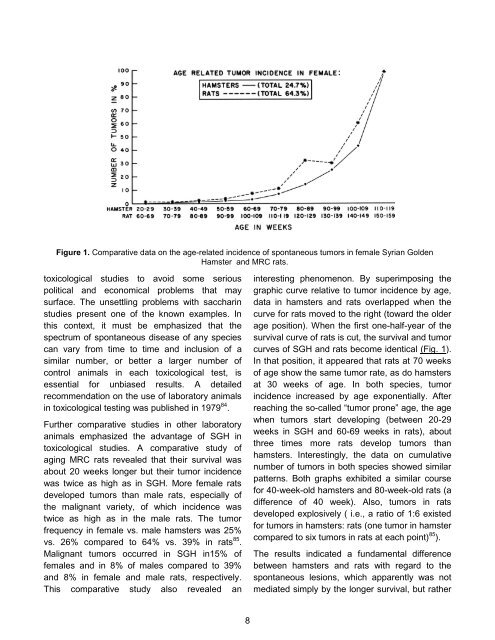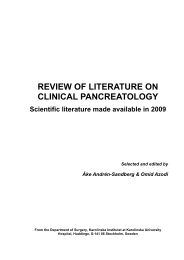Download PDF - The Pancreapedia
Download PDF - The Pancreapedia
Download PDF - The Pancreapedia
You also want an ePaper? Increase the reach of your titles
YUMPU automatically turns print PDFs into web optimized ePapers that Google loves.
Figure 1. Comparative data on the age-related incidence of spontaneous tumors in female Syrian Golden<br />
Hamster and MRC rats.<br />
toxicological studies to avoid some serious<br />
political and economical problems that may<br />
surface. <strong>The</strong> unsettling problems with saccharin<br />
studies present one of the known examples. In<br />
this context, it must be emphasized that the<br />
spectrum of spontaneous disease of any species<br />
can vary from time to time and inclusion of a<br />
similar number, or better a larger number of<br />
control animals in each toxicological test, is<br />
essential for unbiased results. A detailed<br />
recommendation on the use of laboratory animals<br />
in toxicological testing was published in 1979 84 .<br />
Further comparative studies in other laboratory<br />
animals emphasized the advantage of SGH in<br />
toxicological studies. A comparative study of<br />
aging MRC rats revealed that their survival was<br />
about 20 weeks longer but their tumor incidence<br />
was twice as high as in SGH. More female rats<br />
developed tumors than male rats, especially of<br />
the malignant variety, of which incidence was<br />
twice as high as in the male rats. <strong>The</strong> tumor<br />
frequency in female vs. male hamsters was 25%<br />
vs. 26% compared to 64% vs. 39% in rats 85 .<br />
Malignant tumors occurred in SGH in15% of<br />
females and in 8% of males compared to 39%<br />
and 8% in female and male rats, respectively.<br />
This comparative study also revealed an<br />
8<br />
interesting phenomenon. By superimposing the<br />
graphic curve relative to tumor incidence by age,<br />
data in hamsters and rats overlapped when the<br />
curve for rats moved to the right (toward the older<br />
age position). When the first one-half-year of the<br />
survival curve of rats is cut, the survival and tumor<br />
curves of SGH and rats become identical (Fig. 1).<br />
In that position, it appeared that rats at 70 weeks<br />
of age show the same tumor rate, as do hamsters<br />
at 30 weeks of age. In both species, tumor<br />
incidence increased by age exponentially. After<br />
reaching the so-called “tumor prone” age, the age<br />
when tumors start developing (between 20-29<br />
weeks in SGH and 60-69 weeks in rats), about<br />
three times more rats develop tumors than<br />
hamsters. Interestingly, the data on cumulative<br />
number of tumors in both species showed similar<br />
patterns. Both graphs exhibited a similar course<br />
for 40-week-old hamsters and 80-week-old rats (a<br />
difference of 40 week). Also, tumors in rats<br />
developed explosively ( i.e., a ratio of 1:6 existed<br />
for tumors in hamsters: rats (one tumor in hamster<br />
compared to six tumors in rats at each point) 85 ).<br />
<strong>The</strong> results indicated a fundamental difference<br />
between hamsters and rats with regard to the<br />
spontaneous lesions, which apparently was not<br />
mediated simply by the longer survival, but rather












